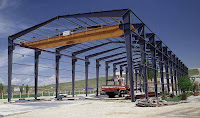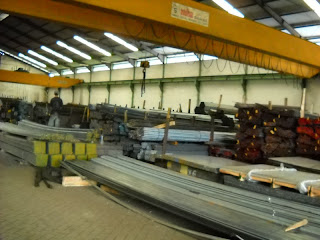DESIGN OF STEEL STRUCTURES (P1)
 DESIGN OF STEEL STRUCTURES (P1). In this first part I will try to describe the terms - the terms and regulations of the steel structure. In the next section I will discuss later about the calculation and standardization. So do not waste - waste materials this blog to you all, engineering (particularly beginners) to get the material - material about Civil Engineering. I mean talk about Planning Procedures for Building Steel Structure is as a reference for planners and implementers in doing the job of planning and execution of steel structures.
DESIGN OF STEEL STRUCTURES (P1). In this first part I will try to describe the terms - the terms and regulations of the steel structure. In the next section I will discuss later about the calculation and standardization. So do not waste - waste materials this blog to you all, engineering (particularly beginners) to get the material - material about Civil Engineering. I mean talk about Planning Procedures for Building Steel Structure is as a reference for planners and implementers in doing the job of planning and execution of steel structures.Common standards and regulations - the provision of Technical Planning and Execution of steel structures for build
ings, other buildings or structures that have a common character with the building structure. These ordinances include:
Minimum provisions for planning, fabrication, construction, and modification or renovation of steel structure work, in accordance with limit state design method.
Structural design of buildings or other structures, including faucets made of steel.
The structure and building materials the following:
Steel structural components, with more than 3 mm thick.
Yield stress (fy) structural components of less than 450 Mpa.
In planning the steel structure to be fulfilled the following conditions:
Analysis by computer, must notify the principle of the workings of the program and must be presented with a clear explanation of data input and output data.
Experimental models are allowed when necessary to support the theoretical analysis.
Structural analysis should be done with mathematical models that simulate the real state of the structure in terms of material properties and stiffness elements.
When calculating how to deviate from this procedure, it must follow the following requirements:
The resulting structure can be proved by calculation or experiment and is quite safe.
Responsibility for the irregularities, borne by the planners and implementers concerned.
Calculation or experiment and is submitted to the committee appointed by the superintendent of the building, which consists of experts who are empowered to d
etermine all the information and means it.
Name of responsible person must be written and calculated signature and the date is clear.
A structure is called stable if it is not easily knocked over, tilted, or shifted, over the life of the planned building.
A structure called strong enough and capable of-service when the possibility of failure and loss of ability-structure service during the planned life is small and within acceptable limits.
A structure called a durable if the structure is able to receive wear and tear and damage which is expected to occur during the life of the planned building without excessive maintenance.
The limits deflection must be in accordance with the structure, function of use, nature of loading, as well as elements that are supported by the structure.
Limit the maximum deflection as follows:
Component structure with no load factored
Fixed Charges
Load while
Beams bearing walls or finishing a brittle
L/360
-
Ordinary beam
L/240
-
Column with just first-order analysis
h/500
h/200
The column with the second-order analysis
h/300
h/200
For Reference And Requirements-Requirements All structural steel prior to fabrication, must meet the following requirements:
Test S-05-1989-F: Specification of Building Materials Part B (Building Materials of Iron / Steel)
SNI 07-0358-1989-A: Steel, General Examination Regulations
SNI 07-3014-1992: Steel for General Engineering Purposes
SNI 03-1726-1989: Earthquake Resilience Planning Procedures for Home and Building.
SNI above can you search or search on google, or you can buy it. I can not share it here.
I'll see the next section,



Thank you for sharing. The details that you are sharing in the post look helpful for understanding. It contains useful information about the design of
ReplyDeleteStructural Steel Suppliers.
Inspiring post, very informative and relevant. steel structures
ReplyDeletenice blog!!
ReplyDelete